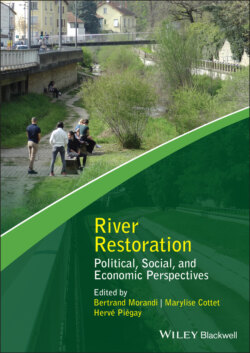Читать книгу River Restoration - Группа авторов - Страница 18
1.2 Genealogy of research on societal issues in river restoration
ОглавлениеAccording to Palmer and Bernhardt (2006, p. 3), “the final research frontier is restoration science that is informed by social science scholarship.” Addresses to the humanities and social sciences to invest more in the field of river restoration are recurrent (e.g. Ormerod 2004; Palmer and Bernhardt 2006; Wohl et al. 2015). However, it is sometimes difficult to know which disciplines are expected to be involved, and what issues should be worked on. Bennett et al. (2011, p. 4) present the “recognition and promotion of human, societal, or cultural requirements for stream restoration” as a shift in restoration science, emphasizing the importance of participation. Palmer and Bernhardt (2006, p. 4) refer to “cultural anthropology, environmental education, landscape architecture and city planners” as “social sciences.” Ormerod (2004, p. 548) refers to the “socio‐economic sciences” with a more explicit focus on economic approaches. All these authors address disciplinary contributions to the field of restoration according to the modern dichotomy between the “human sciences” and the “natural sciences” that is used to structure classical classifications in the scientific field. Other distinctions could have been made, for example the Frascati Manual separates the “social sciences” (e.g. sociology, economics, psychology, geography) from the “humanities and the arts” (e.g. philosophy, history) (OECD 2015, p. 59). These divisions are sometimes inherited from schools of thought or institutional traditions that vary from one country to another. They are sometimes overtaken by fields of research that are structured in an interdisciplinary or even transdisciplinary manner. Many authors publishing on the societal issues of river restoration belong to environmental studies institutes, not to humanities and social sciences institutes. Epistemological positions are also rarely asserted in publications, and it is often difficult to identify the disciplinary tradition to which the authors adhere.
The tendency to break away from disciplinary divisions must be interpreted in the light of the epistemological evolutions that have marked the human and social‐sciences‐based work on environmental issues since the 1970s (e.g. Turner et al. 1994; Lester 1995; Hannigan 2006; Castree et al. 2016). These developments, which have led in particular to the structuring of the field of environmental humanities (Blanc et al. 2017; Emmet and Nye 2017; Heise et al. 2017), have made the disciplinary limits more labile. According to Emmett and Nye (2017, p. 4), “The environmental humanities have become a global intellectual movement that reconceives the relationship between scientific and technical disciplines and the humanities, which are essential to understanding and resolving dilemmas that have been created by industrial society.”
The WoS bibliometric analysis shows that the journals in which such research is published are very rarely humanities and social sciences journals (Figure 1.1). For the most part, studies on societal aspects of restoration are published in journals with an environmental editorial line, explicitly interdisciplinary and applied (e.g. Environmental Management; Journal of Environmental Management, Ecology and Society) or water management (e.g. Water Resources Research, Water Alternatives, River Research and Applications) journals. Journals on environmental economics issues (e.g. Ecological Economics, Water Resources and Economics) are the ones with the strongest disciplinary roots on the social science side. Much work on economic or political issues is published in natural science journals (e.g. Hydrobiologia, Journal of Hydrology). Many societal issues have also been brought into the field of restoration by researchers in the natural sciences. For example, as early as the 1990s, it was the ecologist J. Cairns (1995) who proposed the notion of “ecosocietal restoration.” Certain research approaches, initially undertaken by researchers in ecology, hydrology, or hydromorphology, have largely contributed to placing societal issues at the center of thinking (e.g. Wohl et al. 2005; Palmer and Bernhardt 2006; Dufour and Piégay 2009). This is the case with the Long‐Term Ecological Research (LTER) network and then the Long‐Term Socio‐Ecological Research Network (Redman et al. 2004; Wells and Dougill 2019), which have been important steps in the emergence of more integrated approaches to restoration. This need to cross‐disciplinary divides is expressed in another way in projects such as critical physical geography, which pays “critical attention to relations of social power with deep knowledge of a particular field of biophysical science or technology in the service of social and environmental transformation” (Lave et al. 2014, p. 2).
Figure 1.1 Main international scientific journals in which research on societal issues of river restoration is published (1992–2019).
